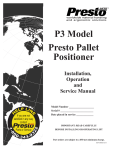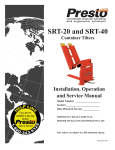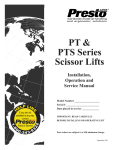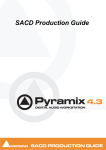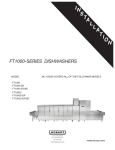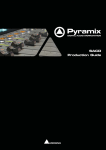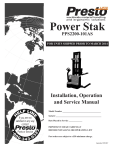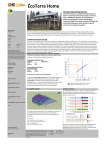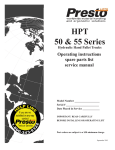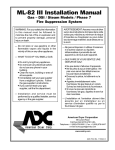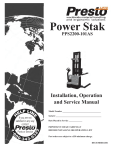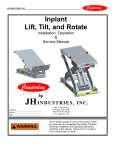Download PDL Series Dock Lift
Transcript
Dock Lift Model: PDL60-60 Installation, Operation and Service Manual Model Number ___________________ Serial # _________________________ Date Placed in Service _____________ IMPORTANT: READ CAREFULLY BEFORE INSTALLING OR OPERATING LIFT Part orders are subject to a $50 minimum charge. September 2015 This manual was current at the time of printing. To obtain the latest, most updated version, please contact the Customer Service Department or go to our website: www.PrestoLifts.com -- you will find a complete list of current Owner’s Manuals to print. PRESTO OWNER’S MANUAL Page 2 DOCK LIFT Contents INTRODUCTION............................................................................... 4 RESPONSIBILITY OF OWNERS AND USERS............................... 5 SAFETY ALERT SYMBOLS AND SIGNAL WORDS..................... 6 SAFE SERVICING OF THE LIFT ..................................................... 7 SAFETY .............................................................................................. 8 INSTALLATION INSTRUCTIONS ................................................. 8 Preparation ......................................................................... . 8 Positioning the Lift ....................................................... ....... 9 Hydraulic Connections .................................................... .... 9 Electrical Connections ..................................................... .. 10 Testing ......................................................................... ...... 10 Completing Installation .................................................... . 10 OPERATING INSTRUCTIONS ..................................................... 11 Operating Procedure ........................................................ .. 11 MAINTENANCE .......................................................................... .. 13 Hazards .............................................................................. 13 Routine Periodic Maintenance ......................................... . 13 TROUBLESHOOTING .................................................................... 14 Troubleshooting Check List ............................................. . 14 Electrical Connections for Single-Phase AC................... ... 18 Electrical Connections for Three-Phase AC ...................... 19 Ordering Replacement Parts .......................................... .... 22 RESTOCKING POLICY................................................................... 23 WARRANTY............................................................................ ........ 24 List of Figures Fig. 1 Safe Servicing of Lift ............................................................ 5 Fig. 2 Mount the Lift Securely ........................................................ 8 Fig. 3 Using Lifting Eyes ............................................................... . 9 Fig. 4 Center the Load ................................................................... 11 Fig. 5 Secure the Load .................................................................. . 11 Fig. 6 Pinch Points ......................................................................... 12 Fig. 7 Parts Identification ............................................................... 16 Fig. 8 Standard 3.2 HP Power Unit ................................................... 17 Fig. 9 Hydraulic Pump and Down Valve ......................................... 17 Fig. 10 Electrical Connections, Lifts Wired for Single-Phase AC ......................................... 18 Fig. 11 Wiring Diagram, Lifts Wired for Single-Phase AC - without limitswitch ...... 18 Fig. 12 Electrical Connections, Lifts Wired for Three-Phase AC .......................................... 19 Fig. 13 Wiring Diagram, Lifts Wired for Single-Phase AC - with limitswitch............ 20 Fig. 14 Hydraulic Connections......................................................... 20 Fig. 15 Hydraulic Diagram .............................................................. 21 Table 1 Electrical Interface, Supplied by Customer............. 21 Table 2 Hydraulic Oil Specifications ................................... 21 PRESTO OWNER’S MANUAL Page 3 DOCK LIFT SECTION 1 INTRODUCTION The PDL series includes Presto Lifts Dock Lift scissor table. The basic PDL series lift may be modified in many ways to meet special requirements for load capacity, vertical travel, table size, power source, and other characteristics. PDL lifts can also be fitted with many optional accessories and modifications to suit the customer’s needs. This manual contains information to acquaint you with the safe and proper installation, use, and upkeep of an PDL series lift table. You should ensure that this manual is available to personnel working with and on the lift table and require its use by these personnel. PDL lift tables are designed for lifting and vertical positioning of equipment and materials in a wide variety of industrial settings. The instructions set forth in this manual are not necessarily allinclusive, as Presto Lifts cannot anticipate all conceivable or unique situations. In the interest of safety, please read all of this manual carefully, and be familiar with its contents before you install, use, or service the PDL Lift Table. If you have any questions about any of the instructions in this manual, please contact your dealer or Presto Lifts. Presto’s product warranty is shown on the back cover of this manual. This instruction manual is not intended to be or to create any other warranty, express or implied, including any implied warranty of merchantability or fitness for a particular purpose, all of which are hereby expressly excluded. As set forth more specifically in the product warranty, Presto’s obligation under that warranty is limited to the repair or replacement of defective components, which shall be the buyer’s sole remedy, and Presto Lifts shall not be liable for any loss, injury, or damage to persons or property, nor for any direct, indirect, or consequential damage of any kind resulting from the PDL lift table. PRESTO OWNER’S MANUAL Page 4 DOCK LIFT Responsibility of Owners and Users Inspection and Maintenance The device shall be inspected and maintained in proper working order in accordance with Presto’s owner’s manual. Removal from Service Any device not in safe operating condition such as, but not limited to, excessive leakage, missing rollers, pins, or fasteners, any bent or cracked structural members, cut or frayed electric, hydraulic, or pneumatic lines, damaged or malfunctioning controls or safety devices, etc. shall be removed from service until it is repaired to the original manufacturer’s standards. Repairs All repairs shall be made by qualified personnel in conformance with Presto’s instructions. Operators Only trained personnel and authorized personnel shall be permitted to operate PowerStak. Before Operation Before using the device, the operator shall have: • Read and/or had explained, and understood, the manufacturer’s operating instructions and safety rules. • Inspected the device for proper operation and condition. Any suspect item shall be carefully examined and a determination made by a qualified person as to whether it constitutes a hazard. All items not in conformance with Presto’s specification shall be corrected before further use of the PowerStak. During Operation The device shall only be used in accordance with this owner’s manual. • Do not overload. • Ensure that all safety devices are operational and in place. Modifications or Alterations Modifications or alterations to any Presto industrial positioning equipment shall be made only with written permission from Presto. PRESTO OWNER’S MANUAL Page 5 DOCK LIFT SAFETY ALERT SYMBOLS AND SIGNAL WORDS The safety of all persons operating, maintaining, repairing, or in the vicinity of this equipment is of paramount concern. This is a powerful machine with moving parts, and is capable of causing personal injury if proper precautions are not taken. Therefore, throughout this manual, certain hazards have been identified which may occur in the use of the machine, and there are appropriate instructions or precautions which should be taken to avoid these hazards. In some cases, there are consequences which may occur if instructions or precautions are not followed. Below are the symbols and signal words along with their definitions referenced from ANSI Z535.4 - Product Safety Signs and Labels. Safety Alert Symbols These are the safety alert symbols.. They are used to alert you to potential physical injury hazards. Obey all safety messages that follow this symbol to avoid possible injury or death. For use with DANGER signal word (Red Background) For use with WARNING signal word (Orange Background) For use with CAUTION signal word (Yellow Background) Signal Words The meaning of different signal words as defined by ANSI Standard Z535.4 indicates the relative seriousness of the hazardous situation. DANGER indicates a hazardous situation which, if not avoided, will result in death or serious injury. (Red Background) WARNING indicates a hazardous situation which, if not avoided, could result in death or serious injury. (Orange Background) (Yellow Background) CAUTION, used with the safety alert symbol, indicates a hazardous situation which, if not avoided, could result in minor or moderate injury. NOTICE is used to address practices not related to personal injury. (Blue Background) SAFETY INSTRUCTIONS SAFETY INSTRUCTIONS (or equivalent) signs indicate safetyrelated instructions or procedures. (Green Background) PRESTO OWNER’S MANUAL Page 6 DOCK LIFT Rotate the chocks into position SAFE SERVICING OF THE LIFT WARNING ! Only authorized personnel should perform inspection or maintenance and service procedures. Unauthorized personnel attempting these procedures do so at the risk of severe injury or death. Working position DANGER ! Working position Failure to properly adhere to lift blocking procedures is to risk the sudden and uncontrolled descent of the lift during maintenance or inspection. A falling lift can cause severe injury or death. Storage position Figure 1 – Safe Servicing of Lift This procedure describes the only factory-approved method of working under a lift. Follow these instructions EVERY time you plan to reach or crawl beneath the lift to perform service or maintenance – no matter how momentary that might be. If the factory-provided maintenance device is damaged or missing, stop immediately and consult the factory for assistance. The manufacturer is not liable for your failure to use the approved maintenance device(s) and procedures that have been provided. 1. Any load must be removed from the lift prior to engaging the maintenance device(s). These devices are designed to support an unloaded lift only. Failure to remove the load from the lift prior to blocking could cause the failure of the maintenance device(s) and allow the lift to fall unexpectedly. This can result in personal injury or death, or permanent damage to the maintenance device(s) and/or the lift. 2. Raise the lift to its fully raised position. If you do not, the maintenance device(s) may not be able to be placed properly in its/their designed blocking position. 3. Remove the maintenance device(s) from its/their storage location and place it/them into the engaged position as shown in Figure 1. (Note: further information may be useful here to provide additional instructions as to the location and method of storage and engaged positions). 4. Lower the lift until it makes complete contact with the maintenance device(s). Re-check to ensure that all provided devices are fully and securely engaged. If the device(s) is/are not fully engaged the lift could fall unexpectedly, resulting in permanent damage to the device(s) or the lift. PRESTO OWNER’S MANUAL DANGER ! If for any reason you are unable to lower the lift completely onto the maintenance device(s), stop immediately and consult the factory. Failure to properly use the factory approved maintenance device(s) could result in severe injury or death. 5. (For single-acting hydraulic, and pneumatic lifts) Once the maintenance device(s) is/are properly and securely engaged, continue to press the down button, valve or switch for an additional 5-10 seconds to relieve all pressure in the operating system (add more specifics here as required for pneumatic lifts). WARNING ! Failure to relieve operating system pressure could result in the sudden and unexpected release of high pressure fluids (or air) during maintenance and/or repair of the lift and result in severe injury or death. 6. Follow OSHA electrical lock-out/tag-out procedures. Disconnect and tag all electrical and/or other power sources to prevent an unplanned or unexpected actuation of the lift. 7. Once inspection or work is complete, reverse the performance of the steps above to raise the lift off the maintenance device(s) and place the device(s) back into its/ their designated storage position(s). Page 7 DANGER ! HIGH VOLTAGE ! – Disconnect and/or lock out the electrical supply to the power unit prior to any installation or maintenance being performed. DOCK LIFT SAFETY The safety of all persons operating, maintaining, repairing, or in the vicinity of the PDL lift table is of paramount concern to Presto Lifts. The lift table is a powerful machine with moving parts, and is capable of causing personal injury if proper precautions are not taken. Therefore, throughout this manual, Presto Lifts has identified certain hazards which may occur in the use of the lift table, and provided appropriate instructions or precautions which should be taken to avoid these hazards. In some cases, Presto Lifts has also pointed out the consequences which may occur if Presto’s instructions or precautions are not followed. Presto Lifts uses the following system of identifying the severity of the hazards associated with its products: DANGER - Immediate hazard which will result in severe personal injury or death. WARNIN - Hazard or unsafe practice which could result in severe personal injury or death. CAUTION - Hazard or unsafe practice which could result in minor personal injury or property damage. Please read and follow this instruction manual, including all safety instructions and precautions, carefully and completely. INSTALLATION INSTRUCTIONS Preparation Before you start to install the lift, check for local codes and ordinances which may apply. It is your responsibility to obtain any necessary permits. Read all of these installation instructions carefully. Be sure to read and understand all of the warnings! If your unit is designed to be installed in a pit, check the pit before you start to install the lift. Measure the length and width of the lift table, then measure the pit, and be sure the pit allows adequate clearance. Does the pit have 90° angles at each corner? To check, measure across the opposite corners of the pit. The measurement on each diagonal should be the same, within 1/2 inch. The walls of the pit should be vertical. Check with a carpenter’s square. If the power unit will be mounted away from the lift (“external power unit”), check the mounting arrangement for the power unit. The power unit should be sheltered from the weather. It should be mounted within 30 feet of the lift to minimize the pressure drop in the hydraulic system. Be sure the hydraulic lines have been installed properly. Note: Certain PDL models, including dock lifts, require handrails. Throughout this manual, the handrails have been omitted for clarity. Use lag bolts to hold the unit down (unless it is mounted on casters). If necessary, insert shims to level the lift. Grout or shim the area under each side rail with cement. The side rails must be supported. Mount the lift on a firm, level surface. Lag plates Fig. 2 – Mount the Lift Securely PRESTO OWNER’S MANUAL Page 8 DOCK LIFT The chain should pull straight up Fig. 3 – Using Lifting Eyes Chain spreader bar Eye bolt Captive nut Base nut WARNING! Protect the power unit from rain or moisture. If the electrical parts in the power unit get wet, workers may be hurt by electrical shock. The electrical parts may fail if they are wet. WARNING! Move the lift into position, supporting the base of the lift. If the lift has a hinged throwover plate, set the lift in position so the plate is in the appropriate orientation. Install the lift as shown in Figure 2. Unless the lift is mounted on casters, lag the lift to the floor. The electric motor in the lift can create sparks. Don’t install the power unit in an area where flammable gases may be present. Do not hang the lift from the table top. This can damage the lift. CAUTION! If the power unit is mounted within the lift (“internal power unit”), you will need these tools: WARNING! If the lift is mounted on an unstable surface, it may tip over when it is in use. You may be hurt, and the lift and load may be damaged. • A crane or lift truck that can lift the unit safely. • Shims and lag bolts – see the pit plan if the lift will be mounted in a pit. • A masonry drill and bit to drill the holes for the lag bolts. • A power supply with the specified voltage, including fuses or circuit breakers as specified in Figures 12, 13 and 14. If the power unit will be mounted away from the lift (“external power unit”), you will also need: • A compressed air source for clearing the hydraulic lines. • Extra hydraulic oil for flushing the underground lines and refilling the tank. See Table 2 for the oil specifications. Positioning the Lift Remove the shipping material and unskid the lift. On the front of this manual, confirm the model number, serial number, and date the lift is placed in service. You can find the model number and serial number on the name plate. The name plate is located on the crossbar at the base of the cylinders. PRESTO OWNER’S MANUAL If your lift has lifting eyes, as shown in Figure 3, use these when you move the lift. It is best to use a chain spreader, so the chain sections pull straight up. (You must supply the chain and spreader.) Remove the lifting eyes once you have moved the lift. Hydraulic Connections (External Power Units Only – If Internal Power Unit, proceed to step 10.) Install the power unit. Install the hydraulic line between the power unit and the lift as shown on the pit plan. Blow out the hydraulic line with compressed air before Page 9 DOCK LIFT connecting it to the lift table. Replace the solid plug on the hydraulic fluid tank with the vented plug supplied, then attach the vent line to the vented plug. WARNING! Raise and chock the lift, as shown in Figure 1. Make the permanent electrical connections as shown in Figure 10 through 12. Check the level of the hydraulic fluid. On most models, when the lift is fully elevated, the oil should be about 3/4 inch above the bottom of the tank. Use a dipstick to check the oil level, and add oil as necessary. Be sure that the hydraulic line will not be pinched by the lift as it raises or lowers. If you allow the line to be pinched, the lift may not work properly. A hose may break, the lift table may drop suddenly, and someone may be hurt. Testing CAUTION! It is very important to keep the hydraulic oil free of dirt, dust, metal chips, water, and other contamination. Most of the problems with hydraulic systems are caused by contamination in the oil. Be sure to flush all hydraulic lines before connecting remote power units. Clear the area around the lift. Remove any loose wires, lumber, or other materials which might get in the way of the lift as it raises or lowers. Remove the maintenance chocks and warn others to stay away from the lift. Operate the lift through its full range of travel. The lift should rise smoothly with a quiet humming sound, and lower smoothly and quietly. Raise and lower the lift a few times to check the clearances around the lift table. CAUTION! If you do not install the vented plug in the tank, the pump may be damaged. WARNING! As the lift table moves up and down, “pinch points” are created at the places shown in Figure 6. If you are standing too close to the lift when it is moving, your arm or leg may be caught in the moving parts, and you may be hurt. Stay away from the pinch points when the lift is moving. Electrical Connections DANGER! The lift may use a power supply of up to 575 Volts AC. This voltage can kill you. Do not work with the electrical parts unless you are a qualified electrician. Make temporary electrical connections to the lift, as shown in Figure 13 through 15. This temporary set-up will allow you to raise the lift. WARNING! The fusing requirements are shown in Table 1. To avoid fire danger, follow these requirements. On a lift designed for three-phase AC, you must be sure the pump motor is turning in the right direction. The lift table should start to move quickly when you press the “up” or “down” button. If the lift table does not move in 2 or 3 seconds, do not try to operate the lift! Exchange any two of the three-phase leads. If this does not correct the problem, see the troubleshooting instructions at the end of this manual. Completing Installation If your lift is mounted in a pit, align the unit with the sides of the pit. Once you are sure the lift is positioned correctly, mark the locations of the lag holes in the base frame, and drill the holes. If necessary, insert metal shims to level the base of the lift. Insert and tighten the lag bolts to secure the lift. Grout under the base rails to prevent vibration and distortion of the base frame, as shown in Figure 2. If the lift is lowering too quickly or too slowly, you can change the “down speed” by adjusting the flow control. The flow control may be mounted either internally, at the base of the cylinders, or on the external power unit. WARNING! When adjusting the flow control, always raise the lift table and insert the maintenance chocks, as shown in Figure 1. Do not try to adjust the flow control while pressing the “down” button. If you try this, the lift table may drop suddenly, and you may be hurt. CAUTION! If you have a unit designed for three-phase AC and you connect the power so the motor runs backwards, the lift will not operate, and you may damage the pump. Do not operate the lift for more than 2 or 3 seconds if you think the motor might be turning backwards. PRESTO OWNER’S MANUAL It is important that you follow these steps when adjusting the flow control: Page 10 DOCK LIFT • Raise the lift table and insert the maintenance chocks, as shown in Figure 1. • If you want the lift to lower more slowly, turn the control clockwise up to 1/4 turn at a time. If you want the lift to lower more quickly, turn the control counterclockwise up to 1/4 turn. Don’t move the control more than 1/4 turn at a time. • Remove the maintenance chocks, and check the descent speed. • Every time you want to change the adjustment again, raise the table again and insert the maintenance chocks as shown in Figure 1. Test the lift with the rated load. If the lift does not rise, and you hear a loud squealing noise, the pressure relief valve is operating. Contact Presto Lifts for instructions. WARNING! Don’t continue to use the lift if this happens. The pump will overheat very quickly, and may be permanently damaged. Do not try to adjust the relief valve. If you change the setting on the relief valve, you may overwork the lift. This can cause the lift to fail suddenly, and you may be hurt. OPERATING INSTRUCTIONS Operating Procedure Before operating the lift, read and understand this entire section. DANGER! The lift may use a power supply of up to 575 Volts AC. This voltage can kill. Do not work with the electrical parts unless you are a qualified electrician! Locate the lift on a firm, flat surface as shown in Figure 2. Stationary lifts should be lagged to the floor. WARNING! If you place the lift on a soft surface, it may tip over, especially when it is loaded or raised. Someone may be hurt, and the lift and load may be damaged. Load the lift correctly. • Be sure that the load weighs no more than the maximum rated for the lift. The maximum rated load is shown on the platform skirt. WARNING! Do not try to lift a load that exceeds the maximum rating. If you try this, the lift may fail suddenly. Someone may be hurt, and the As a final step, clean up all spilled hydraulic fluid. Spilled hydraulic oil is slippery, and may present a fire hazard. Always place the load in the center of the lift table Fig. 4 – Center the Load PRESTO OWNER’S MANUAL If the load can roll or move, insert chocks, or fasten the load down Fig. 5 – Secure the Load Page 11 DOCK LIFT Fig. 6 – Pinch Points lift and load may be damaged. • Place the load in the center of the lift table, as shown in Figure 4. • Do not try to load the lift while the lift table is moving. • If you are lifting pipes or other objects which may be able to roll or move, fasten them down, or chock them as shown in Figure 5. Operate the lift. Press and hold the “up” button to raise the lift, and “down” to lower it. Release the button when the lift reaches the limit of travel. If the lift does not operate within 2 or 3 seconds, turn off the lift and call a qualified maintenance worker. WARNING! If you hear a squealing noise from the pump, the pressure relief valve is operating. Do not continue to use the lift! The pump will overheat very quickly, and may be permanently damaged. The relief valve is included to protect the machine operators – don’t change the relief pressure setting. Be sure all workers are clear of the lift. Remove any lumber or other material which may fall onto the lift. WARNING! Do not use the unit to lift people unless it has been specially equipped for this purpose. A specially equipped lift will include operator protection, and an excess flow protector to keep the lift from dropping suddenly if a hydraulic line is damaged. Retrofit kits are available if you want to add these features to your lift. Wait until the lift table has stopped. Unload the lift. WARNING! The warning labels on the lift are there for your safety. If you find that the labels are worn or missing, or have been painted over, ask Maintenance to replace the labels before you use the lift. The labels are shown in Figure 7. WARNING! As the lift table moves up and down, “pinch points” are created as shown in Figure 6. Stay away from these pinch points! Part of your body or clothing may become caught, and you may be hurt. PRESTO OWNER’S MANUAL Page 12 DOCK LIFT MAINTENANCE Routine Periodic Maintenance All servicing should be done by qualified personnel. Qualified personnel should be able to read and understand wiring and hydraulic diagrams. They should be able to troubleshoot live electrical circuits safely and in accordance with accepted practice. For safety’s sake, if in doubt, please contact your dealer or Presto Lifts Service Department at (207) 878-0700 or (800) 743-1000. Every month: Visually inspect the leg rollers, center pivot bushings and pins, cylinder clevis pins and bushings, and the leg hinge pins and bushings for signs of wear. Contact Presto for instructions for repair of the center pivot pins and bushings. WARNING! If you are going to repair the center pivot pins and bushings, you must support the lift table in a special way. Each set of leg plates, on both sides of the unit, must be clamped together firmly, using large C-clamps. You cannot use the chocks shown in Figure 1. With the pivot pins removed, they will not support the table top. If you do not support the lift table correctly, the top may drop suddenly when you remove the pivot pins. Please contact Presto for instructions. Before servicing the lift, read and understand this entire section and the section entitled “Operating Instructions.” Hazards There are several hazards you should be aware of as you service the lift: DANGER! The lift may use a power supply of up to 575 Volts AC. This voltage can kill. Do not work with the electrical parts unless you are a qualified electrician! WARNING • As the lift moves up and down, “pinch points” are formed as shown in Figure 6. Keep hands, feet, and loose clothing away from these pinch points. If your hand or arm or a part of your clothing is caught, you may be hurt. • A falling lift can cause severe personal injury. Before working under the lift, raise the lift and insert the maintenance chocks, as shown in Figure 1. Do this every time you work under the lift! • Do not change the setting on the relief valve. If you do change the setting, this may cause a hydraulic part to fail. The hydraulic components in the lift are designed to handle a certain amount of pressure. If the relief valve does not open, this pressure may be exceeded. The lift may drop suddenly. Someone may be hurt, and the lift and load may be damaged. • Release of fluids under high pressure can cause personal injury. Before you open any part of the hydraulic system, be sure to release the hydraulic pressure. Apply oil or WD-40 to the parts listed in the last step. NOTE: Although the bearings are “lifetime lubricated” their performance may be extended by additional periodic lubrication. Check the level and appearance of the hydraulic fluid. First, raise the lift and insert the maintenance chocks, as shown in Figure 1. On most models, when the lift is fully elevated, the oil should be about 3/4 inch above the bottom of the tank. Use a dipstick to check the oil level, and add oil as necessary. Change the oil if it has darkened, or feels gritty or sticky. CAUTION! It is important to use hydraulic fluid with the correct grade and properties. See the hydraulic oil specification in this manual, Table 2. Every six months or 500 hours of operation, whichever comes first: Raise the lift and insert the maintenance chocks, as shown in Figure 1. Check all of the hydraulic fittings and hoses, and repair the connections as necessary. Occasionally the fittings can be worked loose by the vibrations from the power unit. WARNING! If a hydraulic fitting becomes loose, or if a hydraulic hose breaks, the hydraulic fluid • The warning labels on the lift are there for the safety of the operators. See Figure 7. • If the labels are worn or missing, or have been painted over, replace them before releasing the lift for operation. PRESTO OWNER’S MANUAL Page 13 DOCK LIFT may escape from the system under pressure. If the lift is raised when this happens, it can drop quickly. Someone may be hurt, or the lift or load may be damaged. WARNING! This power unit contains a hydraulic pump that is capable of developing excessive pressure. A pressure relief valve is used to set the pressure at the desired level. Tampering with,adjusting, modifying, or removing the relief valve is extremely dangerous and is not recommended. Only a trained hydraulics technician, using a calibrated hydraulic pressure gauge to assure the proper pressure setting is achieved, should make the adjustments to the relief valve. The clear plastic vent line and the cylinder rod(s) should be free of hydraulic fluid. If you find much fluid in either place, the cylinder seals may be leaking. Disassemble the down valve as shown in Figure 11. Blow the valve plunger clean with compressed air. Reassemble and reinstall. Drain and discard the hydraulic fluid. The suction filter is in the tank, at the point where the suction line runs out to the pump. Unscrew the hydraulic filter. Blow the filter clean. Reinstall the filter in the tank and reassemble the hydraulic line. Refill the tank with new hydraulic fluid. CAUTION! If you continue to use fluid after it has “worn out,” the moving parts in the system will wear more quickly. Be sure all of the warning labels are in position and legible. The warning labels are intended to protect your workers. If the labels are missing, or if they have been painted over, replace them. If the motor is not running, check the main disconnect switch, the fuse(s) and the wiring to the motor. Using an external lifting mechanism, such as a crane or fork lift, raise the lift and insert the maintenance chocks as shown in Figure 1. Be sure to lift the hinged end of the table top. The hydraulic oil level may be low. When the lift is raised as far as possible, the oil should be about 3/4 inch above the bottom of the tank. (The exact level varies with different models, especially on models with tanks that tip as the lift elevates.) Use a dipstick to check the oil level. If your lift has an optional up limitswitch, the lift may have reached this upper limit. If the switch is out of adjustment, the lift may not be able to raise completely. Readjust the switch if necessary. WARNING! TROUBLESHOOTING Do not disconnect the up limitswitch. Instead, loosen the adjusting screw, and change the position of the arm. If you do disconnect the switch, when the lift platform moves up, it may not stop at the correct point. If the platform rises above the normal stopping point, the frame of the unit may be damaged. People working nearby may be hurt. Troubleshooting Check List All servicing should be done by qualified personnel. Qualified personnel should be able to read and understand wiring and hydraulic diagrams. They should be able to troubleshoot live electrical circuits safely and in accordance with accepted practice. For safety’s sake, if in doubt, please contact your dealer or the Service Department at Presto Lifts at 800-3439322. Before servicing the lift, read and understand this entire section and the section entitled “Operating Instructions.” WARNING! Before working underneath the lift, always raise the lift and insert the maintenance chocks, as shown in Figure 1. Failure to do so may result in damage to the lift and severe personal injury! On a lift with an external power unit, the tank vent may be plugged. You must remove the solid plug from the tank and insert the vented plug. The vent line must be clear. CAUTION ! Do not continue to hold the “up” button for more than 2 or 3 seconds. You may damage the pump. Check the actual weight of the load. The rated capacity of the lift is shown on the table skirt. On a lift with a three-phase motor, the motor may be “single phasing.” When this happens, the motor hums, but does not turn. If this is the case, one lead of the three-phase line has been interrupted. Check the motor wiring and line fuses. The motor voltage may be too low. Check the voltage at the starter when the motor is under load. The supply voltage should be within ±10% of the rating. If the lift will not raise: PRESTO OWNER’S MANUAL On a lift with a three-phase motor, the motor may be running backwards. If the motor has been wired correctly, the lift should start moving 2 or 3 seconds after you press the “up” button. If it does not, try reversing any two electrical leads. The suction filter may be clogged. Clean the suction filter as described in the section on “Periodic Maintenance.” A vacuum leak may be allowing air into the suction line, Page 14 DOCK LIFT causing cavitation (loss of suction) in the pump. Check all fittings in the suction line, and repair as necessary. CAUTION! If cavitation is allowed to continue, the pump may be damaged, and may have to be replaced. For the lift to raise, the down-valve must be de-energized and fully closed. Check for a problem with the wiring to the down-valve. Check the solenoid in the valve with a volt meter. The valve must be clean and free to operate. To check this, remove the solenoid and then the valve. Look for contamination which could block the valve action. Clean the valve plunger with kerosene, then blow it clean with compressed air. The expansion nut which holds the solenoid should be finger tight only! The down valve may be de-energized. When the lift is lowering, the down valve should be energized and fully open. Check the solenoid in the valve with a volt meter. The valve must also be clean and free to operate. Remove the solenoid, then the down valve. Look for contamination which could block the valve action. Clean the valve plunger with kerosene, then blow it clean with compressed air. The strainer screen over the lower part of the plunger must be clean. See Figure 11. Before reassembling, depress the plunger manually several times to be sure it moves freely. The expansion nut which holds the solenoid should be finger tight only! The flow control may need to be adjusted. The flow control must be partially open to allow the oil to return from the cylinder(s). It is important that you follow these steps when adjusting the flow control: If the pump has been changed, the coupling may not have been installed. See the pump assembly in Figure 11. • Raise the lift and insert the maintenance chocks, as shown in Figure 1. If the lift elevates, but fails to hold a load: • If you want the lift to lower more slowly, turn the control clockwise up to 1¦4 turn at a time. If you want the lift to lower more quickly, turn the control counterclockwise up to 1¦4 turn. Do not move the control more than 1¦4 turn at a time. Raise the lift and insert the maintenance chocks, as shown in Figure 1. WARNING! Failure to chock the legs may result in damage to the lift and severe personal injury! The check valve may be leaking. Dirt on the valve seat will prevent the valve from closing fully. The check valve is mounted in the base of the pump housing, as shown in Figure 11. Remove the check valve cap and inspect the valve for contamination which may be preventing it from closing. You may be able to restore the seal by lightly rapping the ball into the seat using a 1/4” diameter rod and a small hammer. The down-valve may be energized. While the lift is holding a load, the down-valve should be de-energized and fully closed. Check the solenoid in the valve with a volt meter. The valve must also be clean and free to operate. To check this, remove the solenoid and then the valve. Look for contamination which could block the valve action. Clean the valve plunger with kerosene, then blow clean with compressed air. The expansion nut which holds the solenoid should be finger tight only! • Remove the maintenance chocks, and check the speed as the table lowers. • Every time you want to change the adjustment again, raise the table again and insert the maintenance chocks as shown in Figure 1. DANGER! Do not try to adjust the flow control while pressing the “down” button. If you try this, the lift table may drop suddenly, and you may be hurt. If the steps listed above do not solve the problem, please call the Service Department at Presto Lifts at 800-343-9322 The cylinder(s) may be leaking. Look for oil on the cylinder rod(s) and in the vent line. (This may also occur if the oil tank has been overfilled.) If you find much oil in either place, and the tank is not overfilled, the cylinder(s) need to be repacked. See the instructions in this manual on “Repacking Presto Lift Cylinders.” If the lift fails to lower: 1. Raise the lift and insert the maintenance chocks, as shown in Figure 1. WARNING! Failure to chock the legs may result in damage to the lift and severe personal injury! PRESTO OWNER’S MANUAL Page 15 DOCK LIFT the lift and use it immediately. • A supply of new hydraulic oil. Contaminated oil may damage the new packing. • A container to catch the used oil. • A clean place to work. Choose a place which will not be damaged if you spill some oil. Raise the lift and insert the maintenance chocks, as shown in Figure 1. Remove the plastic rod bearing from the cylinder rod. Observe how the wiper ring sits in the rod bearing. Remove the wiper ring and the O-ring from the rod bearing. Do not try to remove the aluminum piston from the cylinder rod, as this will damage the assembly. Loosen the small snap ring. Remove the poly U-cup from the piston. Check the vent plug, and clean it if it appears dirty. CAUTION! While reassembling, it is very important to keep all of the parts free of dirt, dust, metal chips, water, and other contamination. Most of the problems with hydraulic systems are caused by contamination in the oil. Turn off electrical power at the main disconnect or circuit breaker, or unplug the machine. This will prevent the lift from moving accidentally while you are working on it. Disconnect the cylinder supply line at the pump, and place the end into a container to collect the used oil. Disconnect the vent line(s) at the cylinder(s). At the top end of the cylinder rod, remove the “keeper,” and drive out the clevis pin. Push the rod back into the cylinder to drive the hydraulic fluid out through the hose into the container. You may use air pressure at the vent hole to do this. Disconnect the hydraulic line(s) from the cylinder(s). Lift the cylinder(s) out of the lift. Be careful! Each cylinder is heavy! Figure 8 shows the parts inside a J-style cylinder. At the upper end of the cylinder, remove the large snap ring. Pull the rod and piston all the way out of the cylinder. This assembly is heavy! Be careful not to drop it as it comes free. Clean the piston surfaces, and install a new fiber wear ring. Install a new poly U-cup seal, with the open part of the seal facing down. Clean all of the surfaces on the rod bearing. Install a new O-ring and wiper. Replace the rod bearing assembly on the rod. CAUTION! Be careful not to install the wiper backwards. The lip on the wiper should point upwards, as shown in the detail in Figure 8. Clean the bore of the cylinder tube thoroughly. Look for deformation around the hole at the clevis end of the cylinder rod. If necessary, clean up the rod diameter with a file to allow the rod bearing to slide off without damage. Fig. 7 – Parts Identification (lift shown without precautionary labels for clarity) PRESTO OWNER’S MANUAL Page 16 DOCK LIFT Fig. 8 – Standard 3.2 HP Power Unit Fig. 9 – Hydraulic Pump and Down Valve PRESTO OWNER’S MANUAL Page 17 DOCK LIFT Electrical Connections for Single-Phase AC Fig. 10 – Electrical Connections, Lifts Wired for Single-Phase AC If your lift has a dual-voltage motor, determine the correct voltage and make the connections as shown on the nameplate. Connections shown above are for lifts operating on 120 VAC. For lifts operating on 230 VAC, a NEMA L6-15R receptacle is required. The pump, motor, and down valve may be mounted on the lift unit itself (internal power unit) or in a separate location (external power unit). The pump has a built-in relief valve and check valve. The down speed control is pressure-compensated. Fig. 11 – Wiring Diagram, LIfts Wired for Single-Phase AC – without limitswitch PRESTO OWNER’S MANUAL Page 18 DOCK LIFT Electrical Connections for Three-Phase AC Figure 12 – Electrical Connections, Lifts Wired for Three-Phase AC Connect the power and control wiring to the proper terminals located in the control panel. The pump, motor and valve may be mounted on the lift unit itself (internal power unit) or in a separate location (external power unit). The control panel may be wall mounted. CAUTION! If on power-up the motor rotates in the wrong direction, don’t continue to operate the lift. You may damage the pump. To correct the problem, interchange any two of the motor leads (T1, T2 or T3). PRESTO OWNER’S MANUAL Page 19 DOCK LIFT Fig. 13 – Wiring Diagram, LIfts Wired for Single-Phase AC – with limitswitch Fig. 14 – Hydraulic Connections PRESTO OWNER’S MANUAL Page 20 DOCK LIFT Fig. 15 – Hydraulic Diagram Table 1 – Electrical Interface, Supplied by Customer Motor Required Fuse Required Fuse Required Fuse Wire Voltage 1.0 HP Motor 3.2 HP Motor 5.0 HP Motor Gauge 120/1/60 20 AMP — — 12 AWG 208/1/60 20 AMP — — 12 AWG 230/1/60 20 AMP — — 12 AWG 208/3/60 10 AMP 12 AMP 20 AMP 14 AWG 230/3/60 10 AMP 12 AMP 20 AMP 14 AWG 460/3/60 5 AMP 6 AMP 10 AMP 14 AWG 575/3/60 5 AMP 5 AMP 7.5 AMP 14 AWG Table 2 – Hydraulic Oil Specifications If the lift will be used at normal ambient temperatures, Presto supplies the unit with CONOCO Ecoterra 32 biodegradeable oil - do not substitute. NOTICE CAUTION! This lift is supplied with: Conoco Ecoterra® 32 Hydraulic Oil. Do not substitute. Ecoterra Hydraulic oil is not compatible with oils containing Zinc. Mixng will result in poor machine performance, could damage hydraulic compoentns, adn will lessen the environmental beneits gained by using Ecoterra Hydraulic Oil. It is very important to keep the hydraulic oil free of dirt, dust, metal chips, water, and other contamination. Most of the problems with hydraulic systems are caused by contamination in the oil. Tank to be full only when cylinders are fully retracted. PRESTO OWNER’S MANUAL Page 21 DOCK LIFT Ordering Replacement Parts Presto Lifts has carefully chosen the components in your unit to be the best available for the purpose. Replacement parts should be identical to the original equipment. Presto Lifts will not be responsible for equipment failures resulting from the use of incorrect replacement parts or from unauthorized modifications to the unit. Presto Lifts can supply all replacement parts for your lift. With your order, please include the model number and the serial number of the unit. You can find these numbers on the name plate. This plate is located within the cabinet, or the angle iron cylinder cross support. To order replacement parts, please call the Presto Parts Department. Parts are shipped subject to the following terms: • FOB factory • Returns only with the approval of our Parts Department. • Credit cards preferred (except parts covered by warranty). • Freight collect for truck (except parts covered by warranty). • Freight - prepaid and invoice for small parcel shipments (except parts covered by warranty). • The warranty for repair parts is 30 days from date of shipment. Parts replaced under warranty are on a “charge-credit” basis. We will invoice you when we ship the replacement part, then credit you when you return the worn or damaged part, and we verify that it is covered by our warranty. Labor is not covered under warranty for Parts orders. Presto Lifts Parts Department 50 Commerce Way, Norton, MA 02766 Telephone: 800-343-9322 FAX: 888-788-6496 Email: [email protected] www.PrestoLifts.com PRESTO OWNER’S MANUAL Page 22 DOCK LIFT RESTOCKING POLICY PARTS Standard parts may be returned with a 23% restocking fee. Modified or custom-engineered parts are not returnable. Unfortunately, due to potentially concealed damage, all sales of electrical assemblies are final. QUALITY ISSUES Should you feel there is a quality problem, please contact the seller to ask questions and gather information on how to rectify the issue. Presto Lift Inc. reserves the right to determine potential credits, as a result of factory defects, based on its inspection of the merchandise. GENERAL All products shipped from our factory have passed Quality Assurance inspection and testing. The carrier of choice has signed for, and accepted the product in new working condition. The customer should inspect to ensure it is not received damaged, has no concealed damage or is not incomplete. Parts orders are determined to be complete based upon Presto Lift, Inc. inspection sheets and carrier shipping weights. PRESTO OWNER’S MANUAL Page 23 DOCK LIFT Presto Lifts Limited Warranty Policy Presto Lifts warrants all of its products against defects in the welded structural frame and, if applicable, scissor legs from faulty material and workmanship for a period of five (5) years from the date of invoice. All other components have a limited warranty against defects in faulty material and workmanship for a two (2) year period from the date of invoice date of invoice and 30 day limited warranty on labor. Please note that prior authorization from Presto Lifts is required on all warranty work. There are no implied warranties of any kind, more specifically, there are no warranties of merchantability or fitness for any particular purpose. Presto Lifts' sole warranty shall be as set forth in this limited warranty. Presto Lifts will elect to repair or replace a defective component without charge, if any components should become defective within the limited warranty period. Proof of purchase is required for warranty. The charge for shipping the defective component is the responsibility of the buyer and must be accompanied with an RMA number. The shipping charge to return the component to the buyer is the responsibility of Presto Lifts, Inc. This limited warranty does not cover labor expense for removal or reinstallation of components after thirty days. This limited warranty shall not cover, among other things: damages resulting from foreign matter or water, failure to provide reasonable and necessary maintenance, and if applicable, use of product while charger is plugged into an AC outlet, or failure to follow operating instructions. The limited warranty is not valid for damage resulting from negligence, accident, unreasonable use, abuse or misuse, exceeding data plate capacities or altering the product without Presto Lifts authorization. Presto Lifts expressly disclaims and excludes any liability for consequential, incidental, indirect or punitive damages or financial loss to people or property resulting from any breach of warranty or the operation or failure of this product. Presto Lifts makes no representation that this product complies with local, state, or federal safety/ product standards codes. Should this product fail to comply in any way with those codes, it shall not be considered a defect of materials or workmanship. Presto Lifts shall not be held liable for any damages resulting from noncompliance. It is the dealer's responsibility to exercise this limited warranty. This limited warranty is provided to the original purchaser (defined as the original end user) and is nontransferable. This constitutes the complete and final agreement involving Presto Lifts and limited warranty obligations for products. PRESTO OWNER’S MANUAL Page 24 DOCK LIFT MANY NEEDS REQUIRE MANY OPTIONS... LET PRESTO MEET THOSE NEEDS! Call Presto Sales for stock or customized lift inquiries: 800-343-9322 Email: [email protected]

























